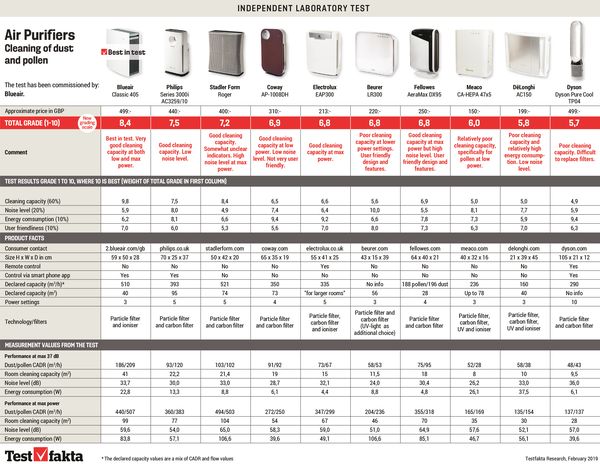A good air purifier can significantly improve air quality at home and at work. But there are big differences in how well the air purifiers actually clean the air, according to Testfakta’s extensive laboratory test.
Particles from exhausts and tyres are leading more and more cities to introduce restrictions on road traffic, diesel vehicles and studded tyres. But our own homes and workplaces are also a major source of harmful air pollutants. Building materials, furniture and clothing release dust, particles and harmful chemicals. People who are allergic to pollen can also be affected by it indoors, since the microscopic particles make their way inside on our clothes and through open windows and ventilation. Many people use an air purifier to reduce these problems and improve the air quality. Since an air purifier also removes bacteria, viruses and dust, it creates a generally healthier indoor environment. This is why air purifiers are becoming an increasingly common feature in homes and offices, even those where no-one suffers allergies or has respiratory problems. The range of both manufacturers and models has also risen sharply, but as a consumer it’s often difficult to interpret and compare the different technical descriptions of capacity that the manufacturers choose to present. And what do the figures tell us about the air purifiers’ ability to actually clean the air? Testfakta has done the tests to find out.  The Swedish Asthma and Allergy Association has drawn up guidelines aimed at all types of consumer. They take account of the air purifier’s performance as well as technical specifications such as sound level and energy consumption. An air purifier used in a bedroom should be able to clean the air twice in one hour. At that power, the sound level should preferably not exceed 37 dB, which corresponds more or less to the sound made by regular mechanical ventilation in a home. To find out whether the manufacturers live up to these basic standards, Blueair commissioned Testfakta Research to carry out a comparative laboratory test of air purifiers in the Nordic and UK markets. Two independent British laboratories, Intertek and SGS-IBR, tested the products’ room cleaning capacity for pollen and dust at 37 dB and on max power, air cleaning and sound level on max power, user friendliness and ozone emissions. Testfakta’s test flags up major differences between the air purifiers. In the overall assessment, the room cleaning capacity carries the heaviest weighting, but sound level, energy consumption and user friendliness also contribute to the grade. Best in test is the Blueair Classic 405, which has by far the greatest cleaning capacity on low power (under 37dB) and the best result on max power for pollen. The air purifiers from Philips and Stadler Form perform relatively well, taking second and third place. At full power, the air purifier from Stadler Form is best at removing dust from the air, but it is also the noisiest of them all. In addition, it consumes the most electricity out of all the products tested. The laboratory test places the products from Meaco, DēLonghi and Dyson lowest in the overall rankings. They are all around four times poorer than the test winner at cleaning the air in a bedroom at 37 dB or on the nearest power setting below that.
The Swedish Asthma and Allergy Association has drawn up guidelines aimed at all types of consumer. They take account of the air purifier’s performance as well as technical specifications such as sound level and energy consumption. An air purifier used in a bedroom should be able to clean the air twice in one hour. At that power, the sound level should preferably not exceed 37 dB, which corresponds more or less to the sound made by regular mechanical ventilation in a home. To find out whether the manufacturers live up to these basic standards, Blueair commissioned Testfakta Research to carry out a comparative laboratory test of air purifiers in the Nordic and UK markets. Two independent British laboratories, Intertek and SGS-IBR, tested the products’ room cleaning capacity for pollen and dust at 37 dB and on max power, air cleaning and sound level on max power, user friendliness and ozone emissions. Testfakta’s test flags up major differences between the air purifiers. In the overall assessment, the room cleaning capacity carries the heaviest weighting, but sound level, energy consumption and user friendliness also contribute to the grade. Best in test is the Blueair Classic 405, which has by far the greatest cleaning capacity on low power (under 37dB) and the best result on max power for pollen. The air purifiers from Philips and Stadler Form perform relatively well, taking second and third place. At full power, the air purifier from Stadler Form is best at removing dust from the air, but it is also the noisiest of them all. In addition, it consumes the most electricity out of all the products tested. The laboratory test places the products from Meaco, DēLonghi and Dyson lowest in the overall rankings. They are all around four times poorer than the test winner at cleaning the air in a bedroom at 37 dB or on the nearest power setting below that.


